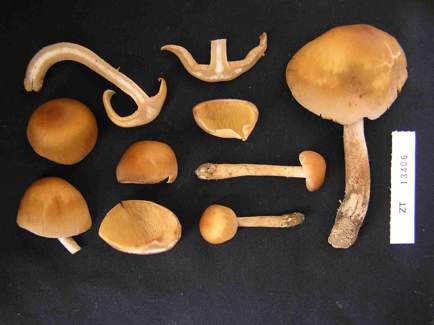 Hebeloma flavidifolium (Photo: E. Horak)
Hebeloma flavidifolium (Photo: E. Horak)Taxonomy
Full name: Hebeloma flavidifolium (Corner) Beker & U. Eberh., MycoKeys 77: 124 (2021)Genus: Hebeloma
Section: Porphyrospora
Basionym:
Psathyrella flavidifolia Corner, Gardens Bulletin Singapore 45 (2): 339 (1994) ["1993"]
Types: MALAYSIA: Pahang:Fraser's Hill (approx. 3.7119°N, 101.7366°E, alt. approx. 1250 m a.s.l.) on soil in montane, tropical woodland, 25 Nov. 1930, E.J.H. Corner (Holotype. herbarium acc. no. E 00204812, HJB19600).
Homotypic synonyms:
- Lacrymaria flavidifolia (Corner) Voto, Rivista Micologica Romana, Bolletino dell'Associazione Micologica Ecologica Romana 107: 94 (2019)
- arrow_drop_downarrow_drop_upEtymology
- arrow_drop_downarrow_drop_upOriginal diagnosisPileus 5-10.5 cm latus, convexus dein planus, centro aliquando depresso, glaber rugulosus subhygrophanus subochraceus, disco cinnamomeo-brunneo; margine veli pannis paucis ornato. Stipes 6-11.5 cm x 6.5-14 mm apicem versus, 5-8 mm basim saepe attenuatum versus, sed apice basique plus minus dilatato, fistulosus, pallide brunneolus, zona floccosa deformi alba 15-20 mm sub apice, deorsum furfuraceus, sine annulo. Lamellae subdecurrentes confertissimae angustae, 70-90 primariae 2-3 mm latae, ordinibus 4-6, pallide vitellinae dein sordide vinaceae. Caro 3-6 mm crassa in pllei centro, firma subhygrophana brunneolo-albida. Sporae 10-12 x 6-7 μm, in cumulo vinaceicinnamomeae, verruculosae amygdallformes.
- arrow_drop_downarrow_drop_upEnglish translationPileus 5-10.5 c. broad, convex then applanate, sometimes depressed in the centre, glabrous wrinkled slightly hygrophanous pale ochraceous, cinnamon-brown on the disc; margin ornate with few velar patches. Stipe 6-11.5 cm x 6.5-14 mm towards the apex, 5-8 mm often tapered towards the base, but more or less enlarged at the apex and the base, fistulose, pale brownish, below the apex with a white floccose misshapen zone of 15-20 mm, below scurfy, without annulus. Lamellae subdecurrent very crowded narrow, 70-90 full-length, 2-3 mm broad, 4-6 length ranks, dull yellow then dingy vinaceous. Context 3-6 mm thick in the pileus centre, firm, subhygrophanous, whitish-brownish. Spores 10-12 x 6-7 μm, vinaceous-cinnamon in mass, verruculose, amygdaliform.
References
Description
- arrow_drop_downarrow_drop_upThresholds
Description of Hebeloma flavidifolium based on 3 collections
- arrow_drop_downarrow_drop_upMacroscopic descriptionPileus: (35) 55–75 (105) mm diameter; shape convex, occasionally broadly umbonate; characters hygrophanous, often remains of universal veil or rugulose; margin characters often involute, occasionally sulcate; viscosity tacky when moist; colour variation two color; colour at centre often orange-brown, occasionally cinnamon.
Lamellae: attachment decurrent tooth; maximum depth 2–3 mm; number of complete lamellae 84–90; presence of tears absent; white fimbriate edge weak.
Cortina presence: yes.
Stipe: (50) 76–89 (116) x (4) 6–9 (14) {median} x (5) 6–9 (12) {basal} mm; stipe Q 8.3–15.0; base shape cylindrical, often clavate, occasionally tapering; floccosity often fibrillose, occasionally fibrous or pruinose at apex; rooting no; thick rhizoids at base often absent, occasionally present;
Context: Texture firm; stipe interior hollow, often stuffed; stipe flesh discolouring often no, occasionally weak; slenderness measure 10.1–24.5; smell odourless; taste bitter where recorded.
Spore deposit colour: Not recorded.
Exsiccata characters: Not recorded.
- arrow_drop_downarrow_drop_upMicroscopic descriptionSpores: shape amygdaloid, occasionally limoniform; colour in microscope brown, often brown pale; guttules no. papilla yes; Spore Code: (O3) O4; P3; D3 D4.
Basidia: (18) 19–33 x 6–9 μm; ave. Q 3.1–3.5; spore arrangement 4 spored;
Cheilocystidia: main shape balloon-shaped, pyriform or ventricose, often cylindrical, occasionally lageniform, lanceolate, napiform or utriform; special features observed occasionally many collapsed in exsiccata, mucronate, septa, short, uniform or yellow contents; cheilocystidia ratios: A/M = 0.90–0.91; A/B = 0.77–1.60; B/M = 0.61–1.35.
Pleurocystidia: seen.
Ixocutis: epicutis thickness (measured from exsiccata) up to 30 μm; ixocutis hyphae width up to 6 μm; ixocutis hyphae encrustation yes; shape of trama elements beneath subcutis isodiametric up to 17 μm wide.
Caulocystidia: Similar to cheilocystidia but larger, up to 60 μm.
- arrow_drop_downarrow_drop_upSpore measurements
- arrow_drop_downarrow_drop_upCheilocystidia measurements
- arrow_drop_downarrow_drop_upHabitat and distributionHebeloma flavidifolium's preferred habitat appears to be montane, tropical woodland or deciduous, montane, tropical woodland with soil and litter or soil. Across our collections, Hebeloma flavidifolium has only been recorded as associating with Quercus (family Fagaceae). No growth habit has been recorded.
According to our current collections, the species is found only in Asia-Tropical. On the continent, collections have been found only in the Peninsular Malaysian montane rain forests WWF ecoregion The World Wildlife Fund (WWF) have divided the world into 867 terrestrial ecoregions. The ecoregion here is estimated by mapping from the GPS coordinates of the collection using data made available by Dinerstein et al (2017). Use this webtool to explore the ecoregions visually or see a full list of current ecoregions on Wikipedia. (tropical & subtropical moist broadleaf forests biome). From collector information, it appears collections have been found only in the 1.9 Forest – Subtropical/tropical moist montane IUCN habitat We map from the collector's description of the habitat to the International Union for Conservation of Nature (IUCN)'s definition using a standardised set of rules. Please see this page for a full list of IUCN habitats.. Within Tropical Asia all our records are from Malesia (Malaysia).
- arrow_drop_downarrow_drop_upMolecular resultsPhylogenetically, based on ITS and MCM7, H. flavidifolium is a sister species of H. ifeleleretorum described from Samoa, but all three form a cluster that received full posterior probability and 92% bootstrap support.
- arrow_drop_downarrow_drop_upCommentaryMorphologically, this species most closely resembles Hebeloma angustilamellatum, originally described from the Yunnan province of China (Yang et al. 2005) and also recorded from northern Thailand and Laos, from which it can be distinguished morphologically by the very strongly ornamented spores (O4), conspicuous even without immersion (those of H. angustilamellatum are O3, so distinctly ornamented but not conspicuous without immersion) and the less conspicuous annulus on the fibrillose stipe of mature basidiomes (H. angustilamellatum has a more persistent annulus, always present, and a stipe, with scattered fibrillose scales, consistently present.)
Geographic distribution
Phenology
- arrow_drop_downarrow_drop_upAdditional cited collections